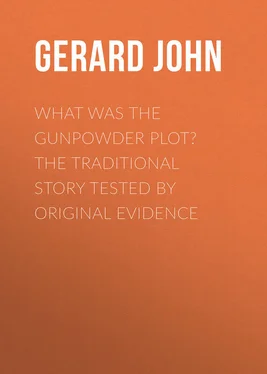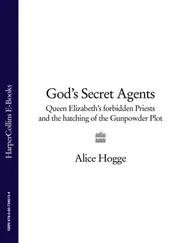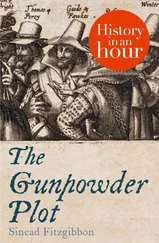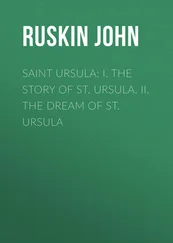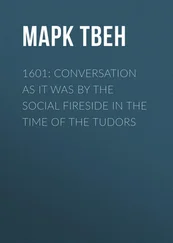John Gerard - What was the Gunpowder Plot? The Traditional Story Tested by Original Evidence
Здесь есть возможность читать онлайн «John Gerard - What was the Gunpowder Plot? The Traditional Story Tested by Original Evidence» — ознакомительный отрывок электронной книги совершенно бесплатно, а после прочтения отрывка купить полную версию. В некоторых случаях можно слушать аудио, скачать через торрент в формате fb2 и присутствует краткое содержание. Жанр: foreign_antique, foreign_prose, на английском языке. Описание произведения, (предисловие) а так же отзывы посетителей доступны на портале библиотеки ЛибКат.
- Название:What was the Gunpowder Plot? The Traditional Story Tested by Original Evidence
- Автор:
- Жанр:
- Год:неизвестен
- ISBN:нет данных
- Рейтинг книги:5 / 5. Голосов: 1
-
Избранное:Добавить в избранное
- Отзывы:
-
Ваша оценка:
- 100
- 1
- 2
- 3
- 4
- 5
What was the Gunpowder Plot? The Traditional Story Tested by Original Evidence: краткое содержание, описание и аннотация
Предлагаем к чтению аннотацию, описание, краткое содержание или предисловие (зависит от того, что написал сам автор книги «What was the Gunpowder Plot? The Traditional Story Tested by Original Evidence»). Если вы не нашли необходимую информацию о книге — напишите в комментариях, мы постараемся отыскать её.
What was the Gunpowder Plot? The Traditional Story Tested by Original Evidence — читать онлайн ознакомительный отрывок
Ниже представлен текст книги, разбитый по страницам. Система сохранения места последней прочитанной страницы, позволяет с удобством читать онлайн бесплатно книгу «What was the Gunpowder Plot? The Traditional Story Tested by Original Evidence», без необходимости каждый раз заново искать на чём Вы остановились. Поставьте закладку, и сможете в любой момент перейти на страницу, на которой закончили чтение.
Интервал:
Закладка:
12
"That which remaineth is but this, to assure you that ere many daies you shall hear that Father Garnet … is layd open for a principall conspirator even in the particular Treason of the Powder." — To Sir Henry Bruncard, P.R.O. Ireland , vol. 218, March 3rd, 1605-6. Also (Calendar) Dom. James I. xix. 10.
13
In Lent, 1603-4. Easter fell that year on April 8th.
14
"About the middle of Easter Term." — Thomas Winter's declaration , of November 23rd, 1605.
15
"Keyes, about a month before Michaelmas." — Ibid. About Christopher Wright there is much confusion, Faukes (November 17th, 1605) implying that he was introduced before Christmas, and Thomas Winter (November 23rd, 1605) that it was about a fortnight after the following Candlemas, i. e. , about the middle of February.
16
The form of this oath is thus given in the official account: "You shall swear by the blessed Trinity, and by the Sacrament you now propose to receive, never to disclose directly or indirectly, by word or circumstance, the matter that shall be proposed to you to keep secret, nor desist from the execution thereof until the rest shall give you leave." It is a singular circumstance that the form of this oath, which was repeated in official publications, with an emphasis itself inexplicable, occurs in only one of the conspirators' confessions, viz., the oft-quoted declaration of T. Winter, November 23rd, 1605. This – as we shall see, a most suspicious document – was one of the two selected for publication, on which the traditional history of the plot depends. Curiously enough, however, the oath, with sundry other matters, was omitted from the published version of the confession.
[Published in the "King's Book: " copy, or draft, for publication, in the Record Office: original at Hatfield. Copy of original Brit. Mus. Add. MSS., 6178, 75.]
17
T. Winter says: "Having upon a primer given each other the oath of secrecy, in a chamber where no other body was, we went after into the next room and heard mass, and received the blessed Sacrament upon the same." — Declaration , November 23rd, 1605.
18
Digby was enlisted "about Michaelmas, 1605;" Rokewood about a month before the 5th of November. Tresham gives October 14th as the date of his own initiation. Examination , November 13th, 1605.
19
This is clear from a comparison of Cecil's private letter to Cornwallis and others (Winwood, Memorials , ii. 170), with the official account published in the Discourse of the manner of the Discovery of the Gunpowder Plot .
20
Criminal Trials , ii. 3.
21
History of England , i. 269 (1883).
22
"We had all been blowne up at a clapp, if God out of His Mercie and just Reuenge against so great an Abomination, had not destined it to be discovered, though very miraculously, even some twelve Houres before the matter should have been put in execution." — Cecil to Cornwallis , November 9th, 1605. Winwood, Memorials , ii. 170.
23
M. l'Abbé Destombes, La persécution en Angleterre sous le règne d'Elizabeth , p. 176.
24
Catholique Apology , third edition, p. 403.
25
Goodman's Court of King James , i. 121.
26
Mr. Sidney Lee, Dictionary of National Biography , sub nom.
27
Goodman's Court of King James , i. 121. Ed. J.S. Brewer.
28
Court of King James , p. 64.
29
Of this affair, – the "Bye" and the "Main," – Goodman says, "[This] I did ever think to be an old relic of the treasons in Q. Elizabeth's time, and that George Brooks was the contriver thereof, who being brother-in-law to the Secretary, and having great wit, small means, and a vast expense, did only try men's allegiance, and had an intent to betray one another, but were all taken napping and so involved in one net. This in effect appears by Brooks' confession; and certainly K. James … had no opinion of that treason, and therefore was pleased to pardon all save only Brooks and the priests." — Court of King James , i. 160.
30
A plain and rational account of the Catholick Faith , etc. Rouen, 1721, p. 200.
31
Dodd, Church History of England , Brussels, 1739, i. 334.
32
Constitutional History , i. 406, note, Seventh Edition. In the same note the historian, discussing the case of Father Garnet, speaks of "the damning circumstance that he was taken at Hendlip in concealment along with the other conspirators." He who wrote thus can have had but a slight acquaintance with the details of the history. None of the conspirators, except Robert Winter, who was captured at Hagley Hall, were taken in concealment, and none at Hendlip, where there is no reason to suppose they ever were. Father Garnet was discovered there, nearly three months later, in company with another Jesuit, Father Oldcorne, on the very day when the conspirators were executed in London, and it was never alleged that he had ever, upon any occasion, been seen in company with "the other conspirators."
33
History , i. 255, note.
34
When James came to the throne Cecil was but a knight. He was created Baron Cecil of Essendon, May 13th, 1603; Viscount Cranborne, August 20th, 1604; Earl of Salisbury, May 4th, 1605.
35
Robert, as the second son, did not succeed to his father's title, which devolved upon Thomas, the eldest, who was created Earl of Exeter on the same day on which Robert became Earl of Salisbury.
36
Fragmenta Regalia , 37. Ed. 1642.
37
He was but little above five feet in height, and, in the phrase of the time, a "Crouchback." King James, who was not a man of much delicacy in such matters, was fond of giving him nicknames in consequence. Cecil wrote to Sir Thomas Lake, October 24th, 1605: "I see nothing yt I can doe, can procure me so much favor, as to be sure one whole day what title I shall have another. For from Essenden to Cranborne, from Cranborne to Salisbury, from Salisbury to Beagle, from Beagle to Thom Derry, from Thom Derry to Parret which I hate most, I have been so walked, as I think by yt I come to Theobalds, I shall be called Tare or Sophie." (R.O. Dom. James I. xv. 105.)
38
History , i. 92.
39
In the same document James I. is spoken of as "the most judycious, learned, and rareste kinge, that ever this worlde produced." (R.O. Dom. James I. xxviii. 29.)
40
Digby to the King, S.P., Spain , Aug. 8. Gardiner, History , ii. 216.
41
At the trial of Essex, Cecil exclaimed, "I pray God to consume me where I stand, if I hate not the Spaniard as much as any man living." (Bruce, Introduction to Secret Correspondence of Sir R. Cecil , xxxiii.)
Of the Spanish pension Mr. Gardiner, after endeavouring to show that originally Cecil's acceptance of it may have been comparatively innocent, thus continues ( History of England , i. 216): "But it is plain that, even if this is the explanation of his original intentions, such a comparatively innocent connection with Spain soon extended itself to something worse, and that he consented to furnish the ambassadors, from time to time, with information on the policy and intentions of the English Government… Of the persistence with which he exacted payment there can be no doubt whatever. Five years later, when the opposition between the two governments became more decided, he asked for an increase of his payments, and demanded that they should be made in large sums as each piece of information was given."
Читать дальшеИнтервал:
Закладка:
Похожие книги на «What was the Gunpowder Plot? The Traditional Story Tested by Original Evidence»
Представляем Вашему вниманию похожие книги на «What was the Gunpowder Plot? The Traditional Story Tested by Original Evidence» списком для выбора. Мы отобрали схожую по названию и смыслу литературу в надежде предоставить читателям больше вариантов отыскать новые, интересные, ещё непрочитанные произведения.
Обсуждение, отзывы о книге «What was the Gunpowder Plot? The Traditional Story Tested by Original Evidence» и просто собственные мнения читателей. Оставьте ваши комментарии, напишите, что Вы думаете о произведении, его смысле или главных героях. Укажите что конкретно понравилось, а что нет, и почему Вы так считаете.
